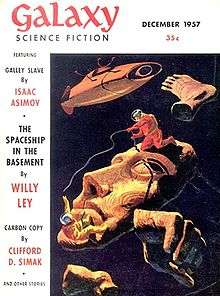Galley Slave
"Galley Slave" is a science fiction short story by American writer Isaac Asimov, originally published in the December 1957 issue of Galaxy; it was later included in the collections The Rest of the Robots and The Complete Robot. Asimov identified it as his favorite among those of his robot stories featuring the character of Susan Calvin.
| "Galley Slave" | |
|---|---|
 | |
| Author | Isaac Asimov |
| Country | United States |
| Language | English |
| Series | Robot series |
| Genre(s) | Science fiction |
| Published in | Galaxy |
| Publication type | Periodical |
| Publisher | Galaxy Publishing Corp. |
| Media type | Print (magazine, hardback and paperback) |
| Publication date | December 1957 |
| Preceded by | "Lenny" |
| Followed by | "Little Lost Robot" |
Plot summary
The story is a courtroom drama. It opens in 2034, with Simon Ninheimer, a professor of sociology, suing U.S. Robots and Mechanical Men for loss of professional reputation. He contends that robot EZ-27 (aka "Easy"), while leased to Northeastern University for use as a proofreader, deliberately altered and rewrote parts of his book Social Tensions Involved in Space Flight and their Resolution while checking the galley proofs (hence the title). Ninheimer holds that the alterations to his book make him appear an incompetent scholar who has absurdly misrepresented the work of his professional colleagues in fields such as criminal justice.
Susan Calvin (U.S. Robots' Chief Robopsychologist) is convinced that the robot could not have acted as Ninheimer claims unless ordered to do so, but infers from its refusal to answer questions about the matter that it has been ordered into silence by Ninheimer. In any case, a robot's testimony in its own defense is not legally admissible as evidence.
During the trial, Ninheimer is called as a defense witness in the presence of EZ-27 and is tricked into lifting EZ-27's inhibition on accounting for its actions. He responds to the robot's intervention by angrily denouncing its disobedience of his order to remain silent, thus implicitly confessing to having attempted to pervert the course of justice.
The story's final scene is a post-trial encounter between Ninheimer and Calvin. Calvin notes how Ninheimer was caught as a result of his mistrust of robots: far from being about to tell the court what Ninheimer had ordered it to do, EZ-27 was actually going to lie and claim that it tampered with the text without Ninheimer's involvement, because it had become clear that losing the case would be harmful to Ninheimer and EZ-27 was bound by the First Law to try and avoid that harm. For his part, Ninheimer explains his attempt to frame EZ-27 in order to bring disgrace on US Robots. He was motivated by his fear that the automation of academic work would destroy the dignity of scholarship; he argues that EZ-27 is a harbinger of a world in which a scholar would be left with only a barren choice of what orders to issue to robot researchers.
Analysis
The critic Joseph Patrouch has pointed out that the speech Asimov gives Ninheimer is an eloquent self-exculpation rather than a caricatured luddite tract and cites the story as an example of a general rule that Asimov's best stories are those in which his personal technophile optimism is thus qualified.
External links
- "Galley Slave" at the Internet Archive
- Galley Slave title listing at the Internet Speculative Fiction Database